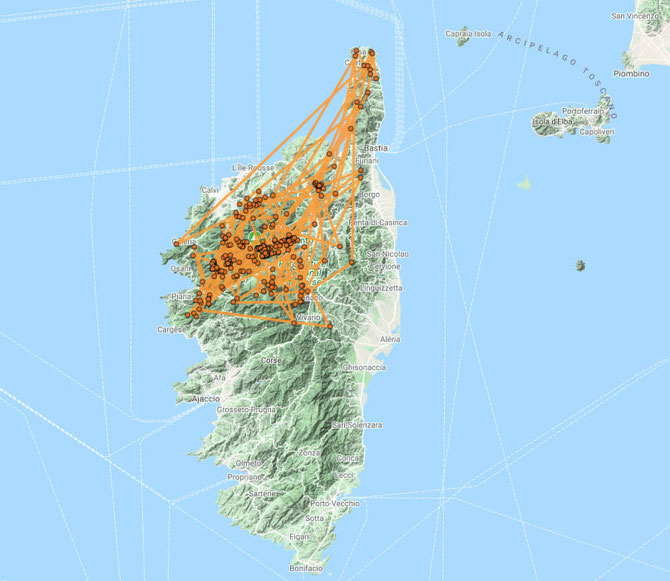
A captive-bred Bearded Vulture that was released on the island of Corsica in 2019, recently left the island but did not venture far.
The Bearded Vulture Cintu hatched last year at Nuremberg Zoo in Germany within the Vulture Conservation Foundation’s (VCF) Bearded Vulture Captive Breeding Network (EEP). The Parc Naturel Régional de Corse (PNRC) then released Cintu and another vulture named Orba on Monday 10 June as part of the efforts to save the Bearded Vulture population on Corsica.
Recent movements of Bearded Vulture Cintu

On 7 June 2020, Cintu started flying away from Corsica at 13:54 with an altitude of 450 m, heading northeast. The young Bearded Vulture began its journey flying over the open sea and gained height early on, reaching an altitude of 903 m. The vulture continued flying on a straight line towards Capraia Isola, a small Italian island, covering about 30 km until it reached land at 14:27. But, the vulture did not stop there. At 14:36, Cintu left Capraia Isola and headed southeast at an altitude ranging from 957 to 42 m. But it turned back midway between Capraia and Elba, covering an additional 25-30 km. PNRC and the VCF closely monitored its movements and alerted Italian vulture colleagues and the local national park to check on the bird. A local team went to the last known location and managed to photograph the Bearded Vulture. Cintu roosted for two days on Capraia Isola and safely returned to Corsica on 9 June.
Bearded Vulture wandering
It is common for young Bearded Vultures to wander away from their mountainous habitats and explore new areas. Throughout the years, we have observed immature Bearded Vultures dispersing from the mountains every year, usually in spring or early summer, both released and wild-hatched birds. The first dispersal movements of Bearded Vultures start in spring from their second calendar year. Typically, after some days or weeks, they return to their mountainous habitats, but sometimes they need to be rescued, like in the case of Bearded Vulture Schils. However, this is the first time we could observe a tagged Bearded Vulture fly over the sea and leave Corsica. Along with Crete, Corsica boasts one of Europe’s only two island populations of Bearded Vultures. Genetic data shows that both island population were connected with the remaining European population before the extinction of the Alpine Bearded Vulture. However, so far, we could not confirm the crossing of the sea.
Saving the Bearded Vulture on Corsica
The population of Bearded Vultures in Corsica is the last vestige of a former meta-population that used to include Sardinia, Sicily, the Alps and Corsica, the Pyrenees and the remaining Iberia Peninsula. It has suffered a severe decline in the last decades, particularly during the last ten years where the numbers of pairs have dropped from 10 to the current 4, while the productivity has plunged even deeper to zero in the past couple of years. This situation has been caused by a combination of factors, mostly the decrease in genetic diversity and therefore increase of inbreeding levels, stochastic events and lack of food resources. In a last attempt to save this population from extinction, an emergency action plan was developed and is currently being implemented.
Genetic considerations are being tackled from two fronts. Firstly, by securing the remaining genetic information by including Corsican birds in the Bearded Vulture EEP through the extraction of eggs from unviable pairs. Secondly, by increasing the genetic diversity in the island by restocking with birds of different bloodlines from the captive breeding network. So far, the extraction of eggs resulted in the hatching of three chicks that are currently being raised in captivity in the hope that they will produce offspring for release in the future. Furthermore, the VCF and PNRC released six Bearded Vultures so far — Montagnolu and Cimatella in 2016, followed by Luna and Ercu in 2017 and Orba and Cintu in 2019.
We are glad that Cintu returned home safely after this exhausting trip. Let’s hope the vulture will have a bright future ahead on Corsica, and successfully breed once it becomes sexually mature!
Sign up to our monthly newsletter and stay updated with Europe’s vultures!







